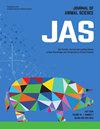Evaluation of gastrointestinal and fecal microbial communities as markers of liver abscess risk in beef feedlot cattle
IF 2.7
2区 农林科学
Q1 AGRICULTURE, DAIRY & ANIMAL SCIENCE
引用次数: 0
Abstract
Liver abscesses (LAs) are a prevalent and costly issue in the beef industry. Microbial translocation from the gastrointestinal tract is believed to be the underlying cause of LAs. However, little is understood about the factors that permit passage of bacteria into the portal bloodstream, or where this translocation is likely to occur. This study used 16S rRNA gene sequencing to characterize the microbial community composition of the rumen, small intestine, large intestine, and feces of steers with edible and abscessed livers of varying severity. The small intestine of steers with severe LAs had increased (P = 0.02) richness and evenness compared to cattle with edible livers. However, there were no differences in the alpha diversity among samples collected at other locations (P ≥ 0.08). Small intestine samples also had a reduced (P < 0.01) Firmicutes to Bacteroidota ratio for cattle with LAs compared to those with edible livers. Prevotellaceae and Synergistaceae family abundance differed in the small intestine of cattle with LAs. Differences in community composition were not identified in fecal, colon, or rumen samples in association with LA occurrence, and there were no differences related to bacteria that have been traditionally considered LA pathogens (e.g., Fusobacteria or Trueperella spp.). These findings suggest that the microbial communities of the small intestine may have an important influence on LA occurrence. However, differences in microbial communities were not identified in rumen and fecal samples that might be used in predicting LA occurrence. Although sampling techniques during the feeding period are still limited and advances in this area would greatly benefit LA research.肉牛饲养场胃肠道和粪便微生物群落作为肝脓肿风险标志物的评价
肝脓肿(LAs)是一个普遍和昂贵的问题,在牛肉行业。来自胃肠道的微生物易位被认为是LAs的根本原因。然而,对于允许细菌进入门静脉血流的因素,或者这种易位可能发生的地方,人们知之甚少。本研究采用16S rRNA基因测序方法,对不同严重程度食用肝和脓肿肝的阉牛瘤胃、小肠、大肠和粪便的微生物群落组成进行了表征。与食用肝脏的牛相比,重度LAs的肉牛小肠丰富度和均匀度均显著提高(P = 0.02)。而其他地点的α多样性差异无统计学意义(P≥0.08)。小肠样本的P &;lt;0.01)与食用肝相比,LAs牛厚壁菌门与拟杆菌门之比。LAs牛小肠中普氏菌科和协同菌科的丰度存在差异。在粪便、结肠或瘤胃样本中,没有发现与LA发生相关的群落组成差异,也没有发现与传统上被认为是LA病原体的细菌(如梭杆菌或Trueperella spp)相关的差异。这些发现表明,小肠微生物群落可能对LA的发生有重要影响。然而,在瘤胃和粪便样本中没有发现可能用于预测LA发生的微生物群落差异。尽管在摄食期的采样技术仍然有限,但这一领域的进展将极大地有利于LA研究。
本文章由计算机程序翻译,如有差异,请以英文原文为准。
求助全文
约1分钟内获得全文
求助全文
来源期刊

Journal of animal science
农林科学-奶制品与动物科学
CiteScore
4.80
自引率
12.10%
发文量
1589
审稿时长
3 months
期刊介绍:
The Journal of Animal Science (JAS) is the premier journal for animal science and serves as the leading source of new knowledge and perspective in this area. JAS publishes more than 500 fully reviewed research articles, invited reviews, technical notes, and letters to the editor each year.
Articles published in JAS encompass a broad range of research topics in animal production and fundamental aspects of genetics, nutrition, physiology, and preparation and utilization of animal products. Articles typically report research with beef cattle, companion animals, goats, horses, pigs, and sheep; however, studies involving other farm animals, aquatic and wildlife species, and laboratory animal species that address fundamental questions related to livestock and companion animal biology will be considered for publication.
 求助内容:
求助内容: 应助结果提醒方式:
应助结果提醒方式:


